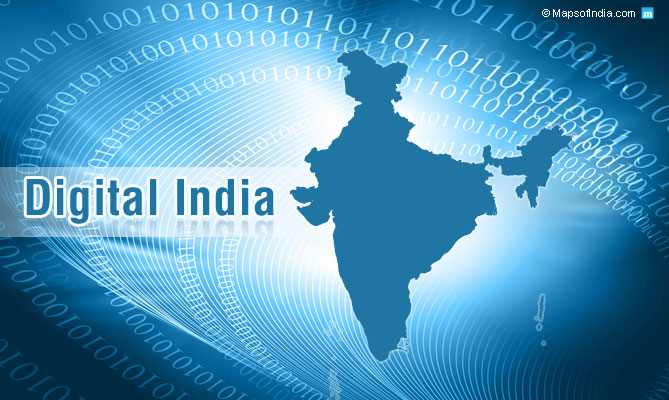Under the Ministry of Electronics, Information and Technology, the central government introduced the Digital India campaign on July 1, 2015, intending to provide government services online through electronic systems. It was implemented considering the enhancement in infrastructure and improving internet connection across the country.
The Digital India campaign offers a digital infrastructure to every citizen for the use of varied purposes. It focuses on governance and services on demand while also fostering the digital empowerment of every citizen. The motto for it states, “Power to Empower.” The initiative also considers redesigning several prevailing schemes that can execute in a synchronized way.
The Digital India campaign includes high-speed internet in rural areas. It acts as a beneficiary to various government schemes such as Sagarmala, Startup India, Make in India, Bharatmala, BharatNet. It merges numerous ideas and thoughts into a good comprehensive vision with taking all those as part of a major goal.
It was set up with a straightforward approach to providing inclusive growth in different sectors, namely manufacturing, electronic services, products and job opportunities. The nine critical pillars of Digital India are e-governance, Broadband highways, electronics manufacturing, access to mobile connectivity everywhere in the country, e-Kranti, early harvest programmes, information for everyone and public internet access programme.
Objectives of Digital India
- To offer easy access to the Common Service Centre (CSC) in all country regions.
- To provide high-speed internet at all gram panchayats across India.
Benefits of Digital India
- There is a rise in digital transactions when it comes to e-governance.
- Under the Bharat Net programme, an optical fibre network of 274,246 km has reached more than 1.15 lakh Gram Panchayats in the country.
- A Common Service Center (CSC) developed under the National e-Governance Project of the Indian government, which offers access to information and communication technology (ICT).
- Digital villages getting set up besides proper facilities like LED assembly unit, solar lighting, sanitary napkin production unit and Wi-Fi choupal.
- Through computer and Internet access, the CSCs present multimedia content related to various fields, namely education, e-governance, health, telemedicine, entertainment and other government and private services through computer and internet access.
- Internet data is undertaken as a key tool for making services reach, and the urban internet penetration stands at 64%.
Initiatives of Digital India
- E-Hospitals: It is a Hospital Management Information System (HMIS), an easy solution in reaching out to hospitals, patients and doctors through this digital platform. Under the campaign, around 420 e-Hospitals had been set up until February 2021.
- DigiLockers: It is a flagship initiative that works on ‘Digital Empowerment’ of the citizens by offering accurate digital documents to the citizen’s digital document wallet.
- BHIM: Bharat Interface for Money is an application that does multiple payment transactions in a simple, easy and rapid manner using Unified Payments Interface (UPI).
- E-Pathshala: NCERT created it as e-Pathshala demonstrates and spreads all educational e-resources for learning, including audio, textbooks, video, periodicals and numerous print and non-print materials through the website as well as a mobile app.
Drawbacks of Digital India
- Many small and medium scale industries have to grapple a lot to take up the new modern technology.
- The internet speed, which comes daily, including the Wi-Fi hotspots, doesn’t work fast in regards to other developed nations.
- The restricted capability of entry-level smartphones for flexible internet access in the country.
- Shortage of skilled workforce in areas such as digital technology creates an issue for all
- Devoid of user-based education
- To find nearly one million cybersecurity experts to know and supervise the growing threat related to digital crime.





